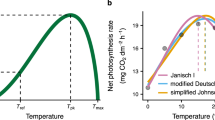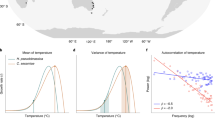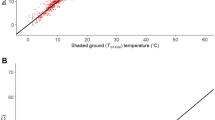Abstract
A major challenge in ecology and evolution is to disentangle the mechanisms driving broad-scale variation in biological traits such as body size, colour, thermal physiology traits and behaviour. Climate has long been thought to drive trait evolution and abiotic filtering of trait variation in ectotherms because their thermal performance and fitness are closely related to environmental conditions. However, previous studies investigating climatic variables associated with trait variation have lacked a mechanistic description of the underpinning processes. Here, we use a mechanistic model to predict how climate affects thermal performance of ectotherms and thereby the direction and strength of the effect of selection on different functional traits. We show that climate drives macro-evolutionary patterns in body size, cold tolerance and preferred body temperatures among lizards, and that trait variation is more constrained in regions where selection is predicted to be stronger. These findings provide a mechanistic explanation for observations on how climate drives trait variation in ectotherms through its effect on thermal performance. By connecting physical, physiological and macro-evolutionary principles, the model and results provide an integrative, mechanistic framework for predicting organismal responses to present climates and climate change.
This is a preview of subscription content, access via your institution
Access options
Access Nature and 54 other Nature Portfolio journals
Get Nature+, our best-value online-access subscription
$32.99 / 30 days
cancel any time
Subscribe to this journal
Receive 12 digital issues and online access to articles
$119.00 per year
only $9.92 per issue
Buy this article
- Purchase on SpringerLink
- Instant access to full article PDF
Prices may be subject to local taxes which are calculated during checkout




Similar content being viewed by others
Data availability
The data that support the findings of this study62 are openly available in Figshare under https://doi.org/10.6084/m9.figshare.19949315.
Code availability
The R code used to compute the sensitivity analysis is available in the GitHub repository: github.com/JRubalcaba/Tb_sensitivity_analysis.
References
Higham, T. E. et al. Linking ecomechanical models and functional traits to understand phenotypic diversity. Trends Ecol. Evol. 36, 860–873 (2021).
Kearney, M. R., Jusup, M., McGeoch, M. A., Kooijman, S. A. & Chown, S. L. Where do functional traits come from? The role of theory and models. Funct. Ecol. 35, 1385–1396 (2021).
Mayr, E. Geographical character gradients and climatic adaptation. Evolution 10, 105–108 (1956).
Gaston, K. J., Chown, S. L. & Evans, K. L. Ecogeographical rules: elements of a synthesis. J. Biogeogr. 35, 483–500 (2008).
Chown, S. L. & Gaston, K. J. Macrophysiology for a changing world. Proc. R. Soc. B 275, 1469–1478 (2008).
Rubalcaba, J. G. & Jimeno, B. Biophysical models unravel associations between glucocorticoids and thermoregulatory costs across avian species. Funct. Ecol. 36, 64–72 (2022).
Anderson, R. O., White, C. R., Chapple, D. G. & Kearney, M. R. A hierarchical approach to understanding physiological associations with climate. Glob. Ecol. Biogeogr. 31, 332–346 (2022).
Angilletta, M. J. Jr, Niewiarowski, P. H. & Navas, C. A. The evolution of thermal physiology in ectotherms. J. Therm. Biol. 27, 249–268 (2002).
Olalla‐Tárraga, M. Á., Rodríguez, M. Á. & Hawkins, B. A. Broad‐scale patterns of body size in squamate reptiles of Europe and North America. J. Biogeogr. 33, 781–793 (2006).
Amado, T., Moreno Pinto, M. G. & Olalla‐Tárraga, M. Á. Anuran 3D models reveal the relationship between surface area‐to‐volume ratio and climate. J. Biogeogr. 46, 1429–1437 (2019).
Castro, K. M. S. A. et al. Water constraints drive allometric patterns in the body shape of tree frogs. Sci. Rep. 11, 1218 (2021).
Clusella-Trullas, S., Terblanche, J. S., Blackburn, T. M. & Chown, S. L. Testing the thermal melanism hypothesis: a macrophysiological approach. Funct. Ecol. 22, 232–238 (2008).
Ghalambor, C. K., Huey, R. B., Martin, P. R., Tewksbury, J. J. & Wang, G. Are mountain passes higher in the tropics? Janzen’s hypothesis revisited. Integr. Comp. Biol. 46, 5–17 (2006).
Bennett, J. M. et al. The evolution of critical thermal limits of life on Earth. Nat. Commun. 12, 1198 (2021).
Sunday, J. M. et al. Thermal-safety margins and the necessity of thermoregulatory behavior across latitude and elevation. Proc. Natl Acad. Sci. USA 111, 5610–5615 (2014).
Muñoz, M. M. The Bogert effect, a factor in evolution. Evolution 76, 49–66 (2021).
Bogert, C. M. Thermoregulation in reptiles, a factor in evolution. Evolution 3, 195–211 (1949).
Huey, R. B., Hertz, P. E. & Sinervo, B. Behavioral drive versus behavioral inertia in evolution: a null model approach. Am. Nat. 161, 357–366 (2003).
Kearney, M. R. & Porter, W. P. NicheMapR—an R package for biophysical modelling: the microclimate model. Ecography 40, 664–674 (2017).
Messier, J., McGill, B. J., Enquist, B. J. & Lechowicz, M. J. Trait variation and integration across scales: is the leaf economic spectrum present at local scales? Ecography 40, 685–697 (2017).
Ricklefs, R. E. & Schluter, D. (eds) Species Diversity in Ecological Communities: Historical and Geographical Perspectives (Univ. Chicago Press, 1993).
Angilletta, M. J. Jr, Steury, T. D. & Sears, M. W. Temperature, growth rate, and body size in ectotherms: fitting pieces of a life-history puzzle. Integr. Comp. Biol. 44, 498–509 (2004).
Pincheira-Donoso, D. The balance between predictions and evidence and the search for universal macroecological patterns: taking Bergmann’s rule back to its endothermic origin. Theory Biosci. 129, 247–253 (2010).
Slavenko, A. et al. Global patterns of body size evolution in squamate reptiles are not driven by climate. Glob. Ecol. Biogeogr. 28, 471–483 (2019).
Stevenson, R. D. Body size and limits to the daily range of body temperature in terrestrial ectotherms. Am. Nat. 125, 102–117 (1985).
Rubalcaba, J. G., Gouveia, S. F. & Olalla‐Tárraga, M. A. A mechanistic model to scale up biophysical processes into geographical size gradients in ectotherms. Glob. Ecol. Biogeogr. 28, 793–803 (2019).
Rubalcaba, J. G. & Olalla‐Tárraga, M. Á. The biogeography of thermal risk for terrestrial ectotherms: scaling of thermal tolerance with body size and latitude. J. Anim. Ecol. 89, 1277–1285 (2020).
Pincheira-Donoso, D., Hodgson, D. J. & Tregenza, T. The evolution of body size under environmental gradients in ectotherms: why should Bergmann’s rule apply to lizards? BMC Evol. Biol. 8, 68 (2008).
Jablonski, D. Biotic interactions and macroevolution: extensions and mismatches across scales and levels. Evolution 62, 715–739 (2008).
Kearney, M. R., Porter, W. P. & Huey, R. B. Modelling the joint effects of body size and microclimate on heat budgets and foraging opportunities of ectotherms. Methods Ecol. Evol. 12, 458–467 (2021).
Campbell-Staton, S. C., Bare, A., Losos, J. B., Edwards, S. V. & Cheviron, Z. A. Physiological and regulatory underpinnings of geographic variation in reptilian cold tolerance across a latitudinal cline. Mol. Ecol. 27, 2243–2255 (2018).
Boretto, J. M., Fernández, J. B., Cabezas-Cartes, F., Medina, M. S. & Ibargüengoytía, N. R. in Lizards of Patagonia (eds Morando, M. & Avila, L. J.) 335–371 (Springer, 2020).
Deutsch, C. A. et al. Impacts of climate warming on terrestrial ectotherms across latitude. Proc. Natl Acad. Sci. USA 105, 6668–6672 (2008).
Araújo, M. B. et al. Heat freezes niche evolution. Ecol. Lett. 16, 1206–1219 (2013).
Sunday, J. M., Bates, A. E. & Dulvy, N. K. Global analysis of thermal tolerance and latitude in ectotherms. Proc. R. Soc. B 278, 1823–1830 (2011).
Hoffmann, A. A., Chown, S. L. & Clusella‐Trullas, S. Upper thermal limits in terrestrial ectotherms: how constrained are they? Funct. Ecol. 27, 934–949 (2013).
Sunday, J. et al. Thermal tolerance patterns across latitude and elevation. Philos. Trans. R. Soc. B 374, 20190036 (2019).
Huey, R. B. & Slatkin, M. Cost and benefits of lizard thermoregulation. Q. Rev. Biol. 51, 363–384 (1976).
Vasseur, D. A. et al. Increased temperature variation poses a greater risk to species than climate warming. Proc. R. Soc. B 281, 20132612 (2014).
Porter, W. P., Mitchell, J. W., Beckman, W. A. & DeWitt, C. B. Behavioral implications of mechanistic ecology. Oecologia 13, 1–54 (1973).
Hertz, P. E., Huey, R. B. & Stevenson, R. D. Evaluating temperature regulation by field-active ectotherms: the fallacy of the inappropriate question. Am. Nat. 142, 796–818 (1993).
Fey, S. B. et al. Opportunities for behavioral rescue under rapid environmental change. Glob. Change Biol. 25, 3110–3120 (2019).
Martin, T. L. & Huey, R. B. Why ‘suboptimal’ is optimal: Jensen’s inequality and ectotherm thermal preferences. Am. Nat. 171, E102–E118 (2008).
R Core Team. A Language and Environment for Statistical Computing (R Foundation for Statistical Computing, 2019).
Campbell, G. S. & Norman, J. M. An Introduction to Environmental Biophysics 2nd edn (Springer-Verlag, 1998).
Mao, J. & Yan, B. Global Monthly Mean Leaf Area Index Climatology, 1981–2015 (ORNL DAAC, 2019).
Meiri, S. et al. Are lizards feeling the heat? A tale of ecology and evolution under two temperatures. Glob. Ecol. Biogeogr. 22, 834–845 (2013).
Marino, S., Hogue, I. B., Ray, C. J. & Kirschner, D. E. A methodology for performing global uncertainty and sensitivity analysis in systems biology. J. Theor. Biol. 254, 178–196 (2008).
Renardy, M., Hult, C., Evans, S., Linderman, J. J. & Kirschner, D. E. Global sensitivity analysis of biological multiscale models. Curr. Opin. Biomed. Eng. 11, 109–116 (2019).
Carnell, R. lhs: Latin hypercube samples. R package version 1.1.1 (2020).
Meiri, S. Traits of lizards of the world: variation around a successful evolutionary design. Glob. Ecol. Biogeogr. 27, 1168–1172 (2018).
Clusella-Trullas, S., Blackburn, T. M. & Chown, S. L. Climatic predictors of temperature performance curve parameters in ectotherms imply complex responses to climate change. Am. Nat. 177, 738–751 (2011).
Bennett, J. M. et al. GlobTherm, a global database on thermal tolerances for aquatic and terrestrial organisms. Sci. Data 5, 180022 (2018).
Roll, U. et al. The global distribution of tetrapods reveals a need for targeted reptile conservation. Nat. Ecol. Evol. 1, 1677–1682 (2017).
Tonini, J. F. R., Beard, K. H., Ferreira, R. B., Jetz, W. & Pyron, R. A. Fully-sampled phylogenies of squamates reveal evolutionary patterns in threat status. Biol. Conserv. 204, 23–31 (2016).
Ives, A. R. R2s for correlated data: phylogenetic models, LMMs, and GLLMs. Syst. Biol. 68, 234–251 (2019).
Johnson, T. F., Isaac, N. J. B., Paviolo, A. & González-Suárez, M. Handling missing values in trait data. Glob. Ecol. Biogeogr. 30, 51–62 (2020).
Goolsby, E. W., Bruggeman, J. & Ané, C. Rphylopars: fast multivariate phylogenetic comparative methods for missing data and within‐species variation. Methods Ecol. Evol. 8, 22–27 (2017).
Koenker, R. et al. Package ‘quantreg’ (R-CRAN, 2018); https://cran.r-project.org/web/packages/quantreg/quantreg.pdf
Griffith, D. A. & Peres-Neto, P. R. Spatial modeling in ecology: the flexibility of eigenfunction spatial analyses. Ecology 87, 2603–2613 (2006).
Bivand, R. R packages for analyzing spatial data: a comparative case study with areal data. Geogr. Anal. 54, 488–518 (2022).
Rubalcaba, J. G. et al. Data: ‘Climate drives global functional trait variation in lizards’. figshare https://doi.org/10.6084/m9.figshare.19949315 (2022).
Acknowledgements
This project has received funding from the European Union Horizon 2020 research and innovation programme under the Marie Skłodowska-Curie grant agreement no. 843094 to J.G.R. The authors S.F.G., F.V., and M.Á.O-T. are members of the INCT-EECBio (CNPq-FAPEG, grant 380733/2017-0). The funders had no role in study design, data collection and analysis, decision to publish or preparation of the manuscript.
Author information
Authors and Affiliations
Contributions
Conceptualization and design of this study was by J.G.R., S.F.G., F.V., M.Á.O-T. and J.S. The model and sensitivity analysis were developed by J.G.R. Data analyses were performed by J.G.R., S.F.G. and F.V. Funding was obtained by J.G.R. with supervision by J.S. and M.Á.O-T. All co-authors wrote the first draft and contributed to subsequent revisions of the manuscript.
Corresponding author
Ethics declarations
Competing interests
The authors declare no competing interests.
Peer review
Peer review information
Nature Ecology & Evolution thanks Gentile Francesco Ficetola and the other, anonymous, reviewer(s) for their contribution to the peer review of this work. Peer reviewer reports are available.
Additional information
Publisher’s note Springer Nature remains neutral with regard to jurisdictional claims in published maps and institutional affiliations.
Supplementary information
Supplementary Information
Supplementary analyses 1–7, Figs. 1–4, Tables 1–7 and references.
Rights and permissions
Springer Nature or its licensor (e.g. a society or other partner) holds exclusive rights to this article under a publishing agreement with the author(s) or other rightsholder(s); author self-archiving of the accepted manuscript version of this article is solely governed by the terms of such publishing agreement and applicable law.
About this article
Cite this article
Rubalcaba, J.G., Gouveia, S.F., Villalobos, F. et al. Climate drives global functional trait variation in lizards. Nat Ecol Evol 7, 524–534 (2023). https://doi.org/10.1038/s41559-023-02007-x
Received:
Accepted:
Published:
Issue date:
DOI: https://doi.org/10.1038/s41559-023-02007-x



